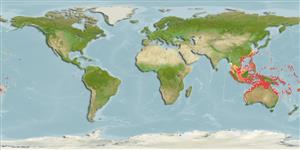Environment: milieu / climate zone / depth range / distribution range
Ekologi
marina revassocierade; djupintervall 2 - 100 m (Ref. 37816). Tropical; 29°N - 34°S, 96°E - 170°W (Ref. 5222)
Pacific Ocean: Cocos-Keeling Islands to Samoa, north to southern Japan, south to southeastern Australia and Lord Howe Island (Ref. 37816).
Length at first maturity / Size / Vikt / Age
Maturity: Lm ?, range 35 - ? cm
Max length : 60.5 cm TL hane/ej könsbestämd; (Ref. 5525)
Taggstrålar i ryggfenan (totalt): 11; Mjukstrålar i ryggfenan (totalt): 15-17; Taggstrålar i analfenan 3; Mjukstrålar i analfenan: 8. Brown spots evenly distributed and packed into hexagonal shapes only on adults which are generally larger (>25 to 45 cm); front portion of spinous dorsal fin about 50% taller than on other species at all sizes (Ref. 37816); small juveniles black with white blotches, becoming more spotted with age (Ref. 48635); further characterized by having ctenoid scales on body; auxiliary scales on body; greatest depth of body 2.7-3.1 in SL; rounded caudal fin; pelvic fins 1.7-2.0 in head length (Ref. 90102); head length 2.4-2.6 times in SL; flat to slightly convex interorbital area, convex dorsal head profile; preopercle with shallow indentation just above the enlarged serrae at angle; straight or slightly convex upper edge of operculum, posterior and anterior nostrils subequal; maxilla reaches to or past vertical at rear edge of eye, ventral edge with blunt hook-like process distally in fish larger than 35 cm SL; 2 rows of teeth on midlateral part of lower jaw (Ref. 89707).
Juveniles are found in shallow coral rubble, adults in isolated coral heads of lagoon and seaward reefs to depths of 82 m. Feeds mainly on sand-dwelling fishes and crustaceans, sometimes on octopuses. In the Hong Kong live fish markets (Ref. 27253). May be ciguatoxic in certain areas (Ref. 37816). Solitary, often seen on open sand and base of reefs (Ref 90102).
Life cycle and mating behavior
Könsmognad | Reproduktion | Lek | Ägg | Fecundity | Larver
Heemstra, P.C. and J.E. Randall, 1993. FAO Species Catalogue. Vol. 16. Groupers of the world (family Serranidae, subfamily Epinephelinae). An annotated and illustrated catalogue of the grouper, rockcod, hind, coral grouper and lyretail species known to date. Rome: FAO. FAO Fish. Synop. 125(16):382 p. (Ref. 5222)
IUCN Red List Status (Ref. 130435)
Threat to humans
Reports of ciguatera poisoning
Human uses
Fiskeri: mindre kommeriell; Akvarium: Offentliga akvarier
Ytterligare information
referenserVattenbrukVattenbruksprofilAvelslinjerGenetikElectrophoresesÄrftlighetSjukdomarBehandlingNutrientsMass conversion
Verktyg
Special reports
Download XML
Internet-källor
Estimates based on models
Preferred temperature (Ref.
123201): 24.3 - 28.8, mean 27.6 °C (based on 698 cells).
Phylogenetic diversity index (Ref.
82804): PD
50 = 0.5000 [Uniqueness, from 0.5 = low to 2.0 = high].
Bayesian length-weight: a=0.01122 (0.00731 - 0.01723), b=3.00 (2.88 - 3.12), in cm total length, based on LWR estimates for this species & Genus-body shape (Ref.
93245).
Trofisk nivå (Ref.
69278): 4.0 ±0.4 se; based on diet studies.
Generation time: 3.9 ( na - na) years. Estimated as median ln(3)/K based on 2
growth studies.
Resiliens (Ref.
120179): Mellan, lägsta populationsfördubblingstid 1,4-4,4 år (K=0.28).
Fishing Vulnerability (Ref.
59153): Low to moderate vulnerability (29 of 100).
Nutrients (Ref.
124155): Calcium = 30.4 [15.3, 63.6] mg/100g; Iron = 0.616 [0.310, 1.274] mg/100g; Protein = 18.6 [17.0, 20.0] %; Omega3 = 0.13 [0.08, 0.21] g/100g; Selenium = 42.7 [22.8, 86.5] μg/100g; VitaminA = 186 [49, 696] μg/100g; Zinc = 1.06 [0.72, 1.57] mg/100g (wet weight);
